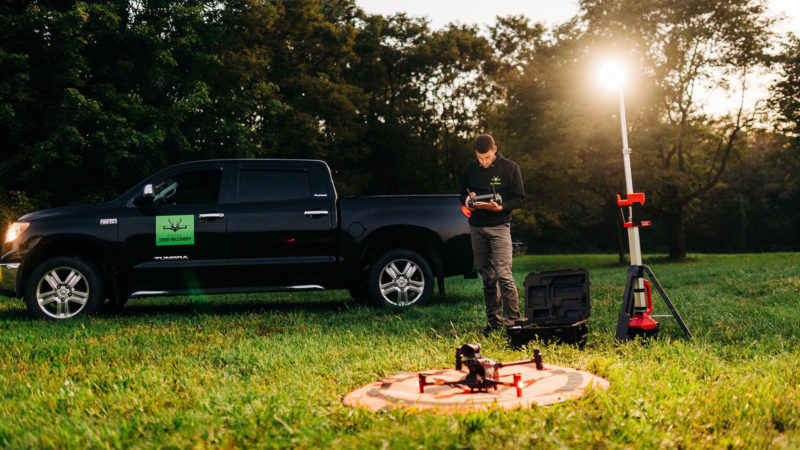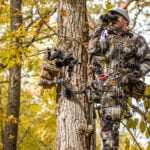In the past, a poor shot on a big buck resulted in a sleepless night full of tossing and turning with a constant replay of the poor shot made. By morning you were likely rounding up a group of friends and family to take up the trail, or better yet, call up a nearby tracking dog with the hopes of locating your quarry. Some of these tracks led to smiles and celebration, while others ended in heartbreak and agony. A situation every bowhunter fears.
Today, another option exists. One which has taken the hunting community by force. Thermal Drone Recovery. Unless you’ve been hiding in the woods for the past year, you have likely seen endless videos of its incredible capability to locate a wounded deer, whether it is dead or still alive. It answers many of the unknowns which come with dried up blood trails and day-old tracks. But one question remains, Will Drones Replace Tracking Dogs? My short answer? No.

Nonetheless, as the popularity of drone recovery grows, there will undoubtedly be more and more hunters who flock to this new advancement in tracking technology and rightfully so. As hunters, we strive to do anything within the law to successfully recover our game and whether or not you agree with its fairness, the thermal drone is unmatched when it comes to successfully locating your wounded deer under the right conditions. Before drone recovery, it was always the “unknown” ending to the trail that bothered me most. Did the deer survive? Had it tucked into a thicket that I overlooked? Unless I had physically laid eyes on the deer after the fact or received trail camera pictures of the surviving deer, days/weeks later, then there was always that gut wrenching feeling of disappointment and failure on my behalf for not recovering the animal. A job left unfinished. Without a doubt more hunters will eventually be willing to pay money in order to bring a close to that chapter of the story.
I have had the opportunity to watch both tracking tools utilized in person and let me tell you, each is amazing in their own unique ways. Watching a good bloodhound and its owner working a blood trail is a sight to see. It’s much like a work of art. The sheer energy, determination, and teamwork that it takes for the hound and owner to work together as one is remarkable and the strategy to collect the clues on an otherwise dried up trail and successfully follow a track to its end is nothing short of incredible.

The same astonishment was had with my experience with drone recovery. It is 100% as effective, and cool, as it appears in the videos! Last winter, I was able to watch Mike Yoder and the Drone Deer Recovery team conduct a herd analysis survey and simulate a recovery scenario with me as the “wounded animal.” I saw firsthand why this method is taking over like wildfire. When they say nothing hides from thermal, they mean it! They located me in a matter of seconds on 2 separate “tracks” and within a few hours the team was also able to conduct an accurate herd count on 2 separate hunting parcels.
It was truly a display of some serious technology. When it comes to tracking a deer, I truly believe Mike and his team would have no problem sectioning out a parcel where your deer was wounded and locating it, dead or alive. Currently, the Drone Deer Recovery team has been actively seeking to change laws in states that do not permit the use of thermal drones. Just another reason why the use of dog tracking will persist, regardless of drone effectiveness.

There are various and complex factors which come into play when using each method. These factors include availability of the service, day/nighttime tracking, temperature, precipitation, humidity, wind, terrain, and foliage, just to name a few. In some cases, one may give you an upper hand over the other, especially when it comes to terrain and weather conditions. Thermal drones thrive in a foliage free canopy, cold temperature tracking situation as they are searching for heat signatures. While a dog, on the other hand, does its best work with a light breeze, high humidity, and a relatively open understory while probing the forest floor for scent. Utilize the correct tool for the situation as you see fit. Be sure to check your state laws before conducting a recovery with either option. Cost of each service is fairly comparable, with prices in the $500-$700 range, depending on who you hire and how much time is involved.
Ultimately, I don’t believe drones will entirely replace tracking dogs. Much like the traditional bow shooters in our hunting community, the tracking dog is a tradition that is deeply rooted in our hunting heritage. Even with the advancement of technology in modern compounds and crossbows, some hunters will still wield the original “stick and string” each fall seeking the ultimate challenge in archery. I personally believe that the tracking dog will be no different. It’s the art of training and the satisfaction brought from the hound successfully tracking down a trophy that will keep the tradition alive.
Conversely, I believe we will continue to see a growing number of thermal drone recovery options across the country as well as state legislation changes both for and against this rising recovery trend.
Will drones replace tracking dogs? No, but as technology and laws change in favor of the use of drones for recovery, it will firmly seat itself among the top of the list for effective tracking methods.

 By
By 



